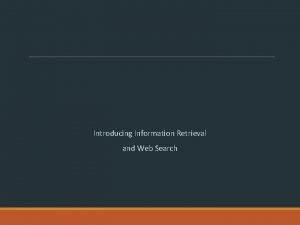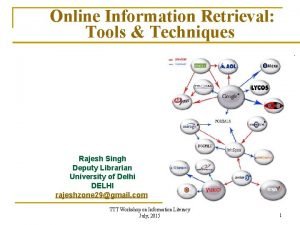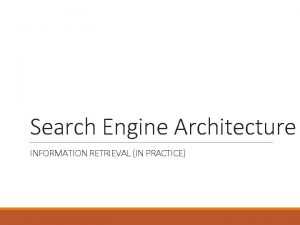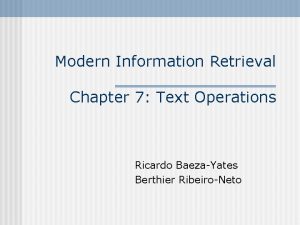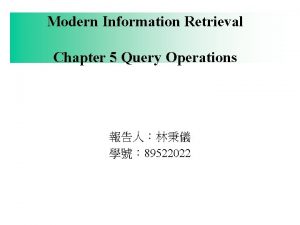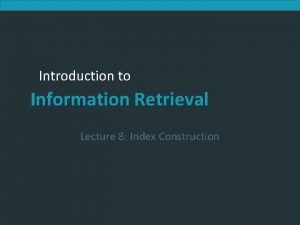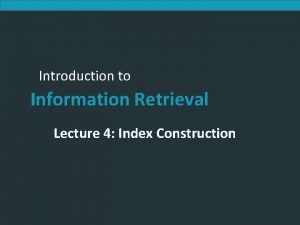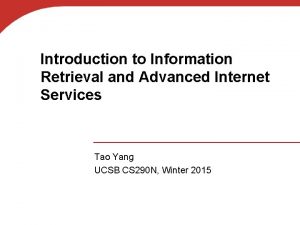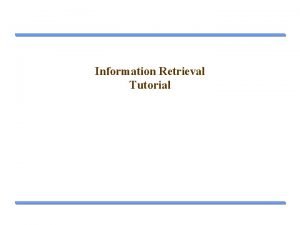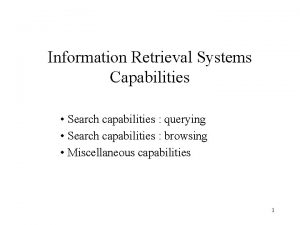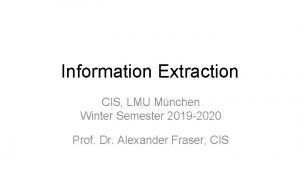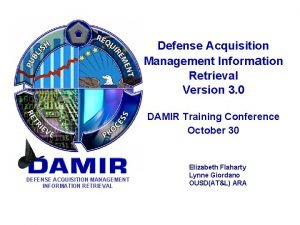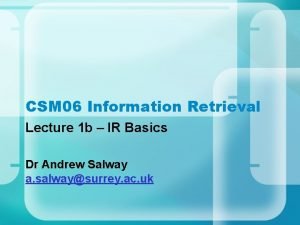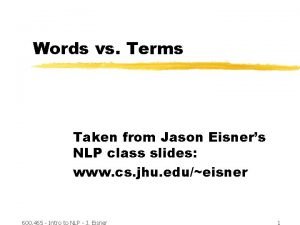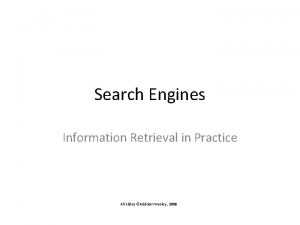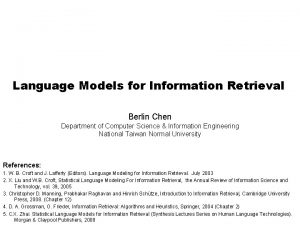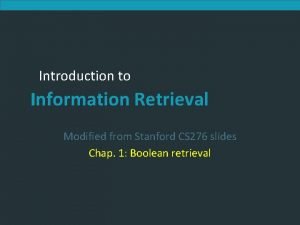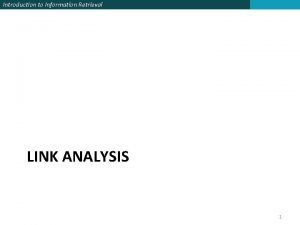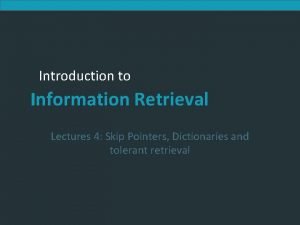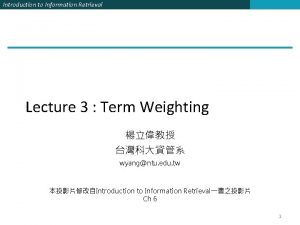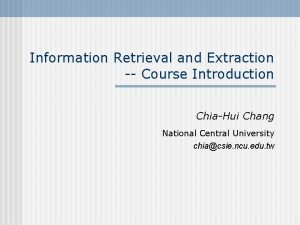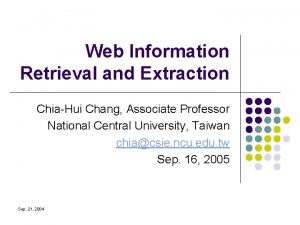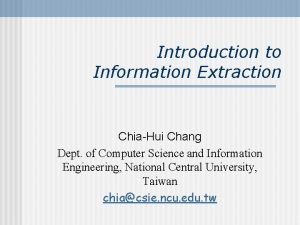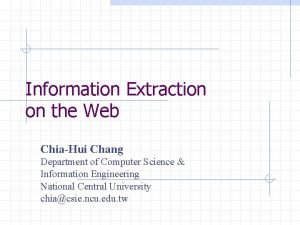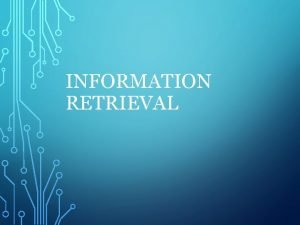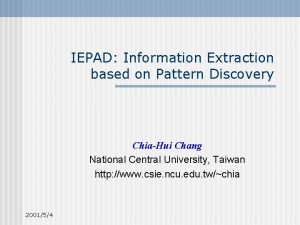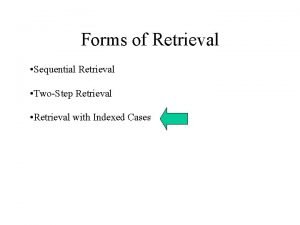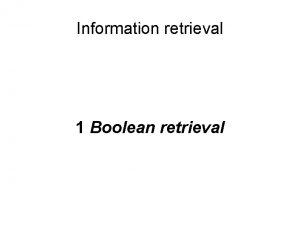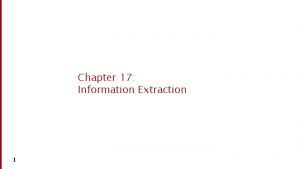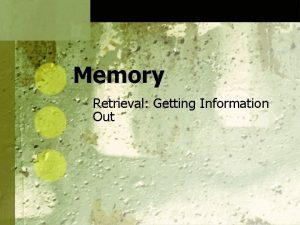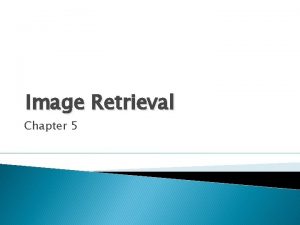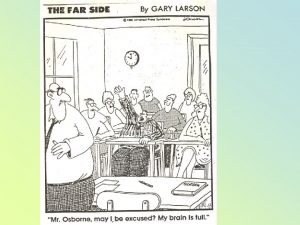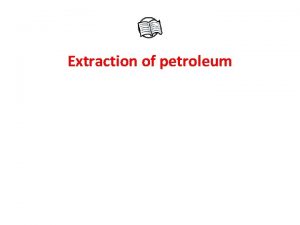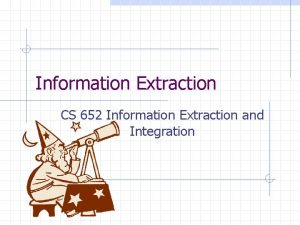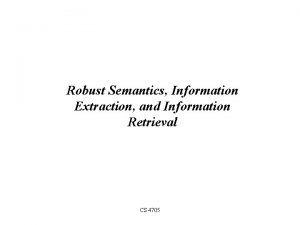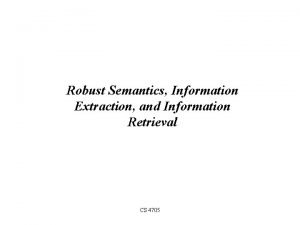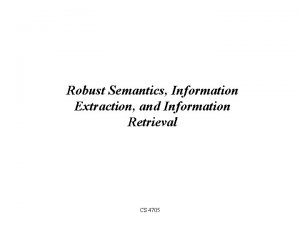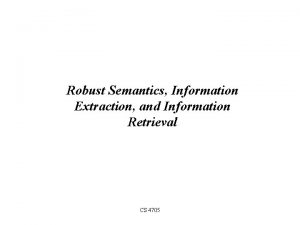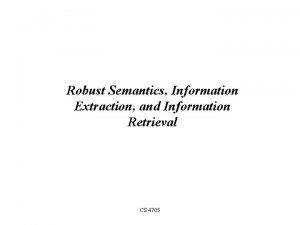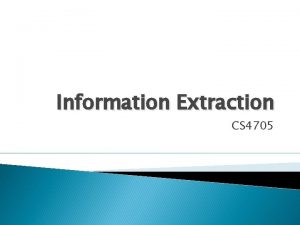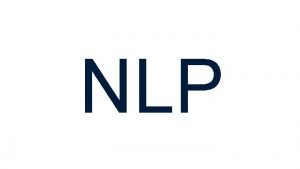Information Retrieval and Extraction ChiaHui Chang Assistant Professor




























- Slides: 28

Information Retrieval and Extraction 資訊檢索與擷取 Chia-Hui Chang, Assistant Professor Dept. of Computer Science & Information Engineering National Central University, Taiwan 1

Information Retrieval l generic information retrieval system select and return to the user desired documents from a large set of documents in accordance with criteria specified by the user l functions » document search the selection of documents from an existing collection of documents » document routing the dissemination of incoming documents to appropriate users on the basis of user interest profiles 2

Detection Need l Definition a set of criteria specified by the user which describes the kind of information desired. » queries in document search task » profiles in routing task l forms » » » keywords with Boolean operators free text example documents. . . 3

Example <head> Tipster Topic Description <num> Number: 033 <dom> Domain: Science and Technology <title> Topic: Companies Capable of Producing Document Management <des> Description: Document must identify a company who has the capability to produce document management system by obtaining a turnkey- system or by obtaining and integrating the basic components. <narr> Narrative: To be relevant, the document must identify a turnkey document management system or components which could be integrated to form a document management system and the name of either the company developing the system or the company using the system. These components are: a computer, image scanner or optical character recognition system, and an information retrieval or text management system. 4

Example (Continued) <con> Concepts: 1. document management, document processing, office automation electronic imaging 2. image scanner, optical character recognition (OCR) 3. text management, text retrieval, text database 4. optical disk <fac> Factors: <def> Definitions Document Management-The creation, storage and retrieval of documents containing, text, images, and graphics. Image Scanner-A device that converts a printed image into a video image, without recognizing the actual content of the text or pictures. Optical Disk-A disk that is written and read by light, and are sometimes associated with the storage of digital images because of their high storage capacity. 5

search vs. routing l l l The search process matches a single Detection Need against the stored corpus to return a subset of documents. Routing matches a single document against a group of Profiles to determine which users are interested in the document. Profiles stand long-term expressions of user needs. Search queries are ad hoc in nature. A generic detection architecture can be used for both the search and routing. 6

Search l l l retrieval of desired documents from an existing corpus Retrospective search is frequently interactive. Methods » indexing the corpus by keyword, stem and/or phrase » apply statistical and/or learning techniques to better understand the content of the corpus » analyze free text Detection Needs to compare with the indexed corpus or a single document » . . . 7

Document Detection: Search 8

Document Detection: Search(Continued) l Document Corpus » the content of the corpus may have significant the performance in some applications l Preprocessing of Document Corpus » » stemming a list of stop words phrases, multi-term items. . . 9

Document Detection: Search(Continued) l Building Index from Stems » key place for optimizing run-time performance » cost to build the index for a large corpus l Document Index » » a list of terms, stems, phrases, etc. frequency of terms in the document and corpus frequency of the co-occurrence of terms within the corpus index may be as large as the original document corpus 10

Document Detection: Search(Continued) l Detection Need » the user’s criteria for a relevant document l Convert Detection Need to System Specific Query » first transformed into a detection query, and then a retrieval query. » detection query: specific to the retrieval engine, but independent of the corpus » retrieval query: specific to the retrieval engine, and to the corpus 11

Document Detection: Search(Continued) l l Compare Query with Index Resultant Rank Ordered List of Documents » Return the top ‘N’ documents » Rank the list of relevant documents from the most relevant to the query to the least relevant 12

Routing 13

Routing (Continued) l Profile of Multiple Detection Needs » A Profile is a group of individual Detection Needs that describes a user’s areas of interest. » All Profiles will be compared to each incoming document (via the Profile index). » If a document matches a Profile the user is notified about the existence of a relevant document. 14

Routing (Continued) l l Convert Detection Need to System Specific Query Building Index from Queries » similar to build the corpus index for searching » the quantify of source data (Profiles) is usually much less than a document corpus » Profiles may have more specific, structured data in the form of SGML tagged fields 15

Routing (Continued) l Routing Profile Index » The index will be system specific and will make use of all the preprocessing techniques employed by a particular detection system. l Document to be routed » A stream of incoming documents is handled one at a time to determine where each should be directed. » Routing implementation may handle multiple document streams and multiple Profiles. 16

Routing (Continued) l Preprocessing of Document » A document is preprocessed in the same manner that a query would be set-up in a search » The document and query roles are reversed compared with the search process l Compare Document with Index » Identify which Profiles are relevant to the document » Given a document, which of the indexed profiles match it? 17

Routing (Continued) l Resultant List of Profiles » The list of Profiles identify which user should receive the document 18

Summary l l l Generate a representation of the meaning or content of each object based on its description. Generate a representation of the meaning of the information need. Compare these two representations to select those objects that are most likely to match the information need. 19

Basic Architecture of an Information Retrieval System Documents Queries Document Representation Query Representation Comparison 20

Research Issues l Given a set of description for objects in the collection and a description of an information need, we must consider l Issue 1 » What makes a good document representation? » How can a representation be generated from a description of the document? » What are retrievable units and how are they organized? 21

Research Issues (Continued) l Issue 2 How can we represent the information need and how can we acquire this representation? » from a description of the information need or » through interaction with the user? l Issue 3 How can we compare representations to judge likelihood that a document matches an information need? l Issue 4 How can we evaluate the effectiveness of the retrieval process? 22

Information Extraction l Generic Information Extraction System An information extraction system is a cascade of transducers or modules that at each step add structure and often lose information, hopefully irrelevant, by applying rules that are acquired manually and/or automatically. 23

Information Extraction (Continued) l l l l What are the transducers or modules? What are their input and output? What structure is added? What information is lost? What is the form of the rules? How are the rules applied? How are the rules acquired? 24

Example: Parser l l l l Transducer: parser Input: the sequence of words or lexical items Output: a parse tree Information added: predicate-argument and modification relations Information lost: no Rule form: unification grammars Application method: chart parser Acquisition method: manually 25

Modules l l Text Zoner turn a text into a set of text segments Preprocessor turn a text or text segment into a sequence of sentences, each of which is a sequence of lexical items, where a lexical item is a word together with its lexical attributes Filter turn a set of sentences into a smaller set of sentences by filtering out the irrelevant ones Preparser take a sequence of lexical items and try to identify various reliably determinable, small-scale structures 26

Modules (Continued) l l l Parser input a sequence of lexical items and perhaps smallscale structures (phrases) and output a set of parse tree fragments, possibly complete Fragment Combiner turn a set of parse tree or logical form fragments into a parse tree or logical form for the whole sentence Semantic Interpreter generate a semantic structure or logical form from a parse tree or from parse tree fragments 27

Modules (Continued) l l l Lexical Disambiguation turn a semantic structure with general or ambiguous predicates into a semantic structure with specific, unambiguous predicates Coreference Resolution, or Discourse Processing turn a tree-like structure into a network-like structure by identifying different descriptions of the same entity in different parts of the text Template Generator derive the templates from the semantic structures 28
 Promotion from assistant to associate professor
Promotion from assistant to associate professor Fok ping kwan
Fok ping kwan What is precision and recall in information retrieval
What is precision and recall in information retrieval Information retrieval and web search
Information retrieval and web search Information retrieval data structures and algorithms
Information retrieval data structures and algorithms Examples of information retrieval tools
Examples of information retrieval tools Signature file structure in information retrieval system
Signature file structure in information retrieval system Sequential search algorithm
Sequential search algorithm Search engine architecture in information retrieval
Search engine architecture in information retrieval Modern information retrieval
Modern information retrieval Query operations in information retrieval
Query operations in information retrieval Recall skip pointers: what is skip span?
Recall skip pointers: what is skip span? Index construction in information retrieval
Index construction in information retrieval Spimi
Spimi Which internet service is used for information retrieval
Which internet service is used for information retrieval Information retrieval tutorial
Information retrieval tutorial Wildcard queries in information retrieval
Wildcard queries in information retrieval Browse capabilities in information retrieval system
Browse capabilities in information retrieval system Link analysis in information retrieval
Link analysis in information retrieval Information retrieval lmu
Information retrieval lmu Defense acquisition management information retrieval
Defense acquisition management information retrieval Advantages of information retrieval system
Advantages of information retrieval system Information retrieval nlp
Information retrieval nlp Information retrieval slides
Information retrieval slides Relevance information retrieval
Relevance information retrieval Stanford information retrieval
Stanford information retrieval Link analysis in information retrieval
Link analysis in information retrieval Which is a good idea for using skip pointers
Which is a good idea for using skip pointers Anthony julius
Anthony julius



